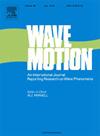带有接头和缺陷的充液管道振动声分析的波动有限元方法
IF 2.5
3区 物理与天体物理
Q2 ACOUSTICS
引用次数: 0
摘要
本文研究了带接头和缺陷的充液管道的波传播和时域特性。充液管道代表弹性声波导,可以用波动有限元法对其进行建模。此外,关节和缺陷代表耦合单元,具有弹性和声学部分,可以用基于有限元的散射矩阵模型来描述。为了改进散射矩阵的计算,提出了一种Craig-Bampton约简方法,其中弹性和声学部件的内部自由度由部件模态的约简基表示。为了解决Craig-Bampton方法的收敛性问题,可以用静力校正矢量丰富构件模态的约简基,以考虑弹性和声学部件界面处的流固耦合效应。分别对两根带有弯曲接头和缺陷的弹性声波导和三根带有t形接头和缺陷的弹性声波导进行了数值实验。在每种情况下,计算并详细讨论了节理的波透射/反射系数。此外,还评估了时域响应,以证明从不同频率的输入波包中检测具有接头的管道网络中的缺陷的可行性。结果表明,流体的影响会强烈影响管道的响应,进而影响缺陷的检测。本文章由计算机程序翻译,如有差异,请以英文原文为准。
A wave finite element approach for the vibroacoustic analysis of fluid-filled pipes with joints and defects
This paper investigates the wave propagation and time-domain behavior of fluid-filled pipes with joints and defects. Fluid-filled pipes represent elasto-acoustic waveguides, which can be modeled with the wave finite element method. Also, joints and defects represent coupling elements, with elastic and acoustic parts, which can be described from finite element-based scattering matrix models. To improve the computation of the scattering matrices, a Craig–Bampton reduction is proposed where the internal degrees of freedom of the elastic and acoustic parts are expressed from reduced bases of component modes. To address convergence issues of the Craig–Bampton method, the reduced bases of component modes can be enriched with static correction vectors to account for the fluid–structure coupling effect at the interface between the elastic and acoustic parts. Numerical experiments are carried out, which concern (i) two elasto-acoustic waveguides with a curved joint and a defect, and (ii) three elasto-acoustic waveguides with a T-shaped joint and a defect. In each case, the wave transmission/reflection coefficient about the joint are computed and discussed in detail. Also, time-domain responses are assessed to demonstrate the feasibility to detect a defect in a network of pipes with a joint from input wave packets of different frequencies. Results show that the influence of the fluid can strongly affect the pipe responses, and the detection of the defect.
求助全文
通过发布文献求助,成功后即可免费获取论文全文。
去求助
来源期刊

Wave Motion
物理-力学
CiteScore
4.10
自引率
8.30%
发文量
118
审稿时长
3 months
期刊介绍:
Wave Motion is devoted to the cross fertilization of ideas, and to stimulating interaction between workers in various research areas in which wave propagation phenomena play a dominant role. The description and analysis of wave propagation phenomena provides a unifying thread connecting diverse areas of engineering and the physical sciences such as acoustics, optics, geophysics, seismology, electromagnetic theory, solid and fluid mechanics.
The journal publishes papers on analytical, numerical and experimental methods. Papers that address fundamentally new topics in wave phenomena or develop wave propagation methods for solving direct and inverse problems are of interest to the journal.
 求助内容:
求助内容: 应助结果提醒方式:
应助结果提醒方式:


